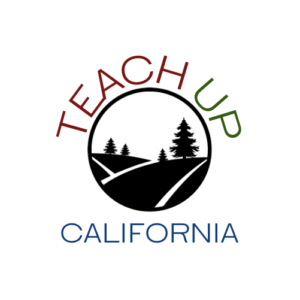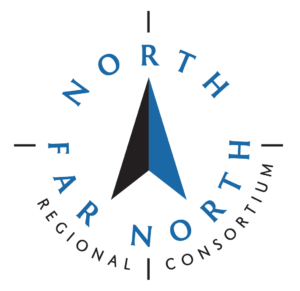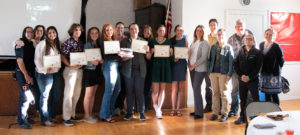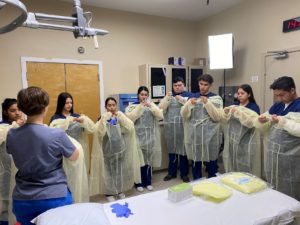E-Blast June 2022
 Shasta College submitted an application on April 29th for a competitive grant through the Office of Public School Construction in collaboration with North State Together. This grant program is the result of the 2021 Budget Act which allocated $250 Million to the Department of General Services and is being administered through the Foundation for California Community Colleges. The focus of the grant is to promote K-16 education collaboratives that create streamlined pathways from high school to postsecondary education and into the workforce. Using innovative and creative approaches, North State Together will increase outcomes through ingenuity and bold systems transformation.
Shasta College submitted an application on April 29th for a competitive grant through the Office of Public School Construction in collaboration with North State Together. This grant program is the result of the 2021 Budget Act which allocated $250 Million to the Department of General Services and is being administered through the Foundation for California Community Colleges. The focus of the grant is to promote K-16 education collaboratives that create streamlined pathways from high school to postsecondary education and into the workforce. Using innovative and creative approaches, North State Together will increase outcomes through ingenuity and bold systems transformation.
The 2021-22 State budget appropriated $200 million (with an additional $300M in the 2022-23 Governor’s proposed budget) for the Learning-Aligned Employment Program (LAEP). This program will allow colleges to offer eligible students the opportunity to earn money to help defray their educational costs while gaining education-aligned, career-related employment. In order to participate in the Learning-Aligned Employment Program, colleges must submit the LAEP Participation Agreement no later than June 30, 2022 to the California Student Aid Commission. For additional information about the Learning-Aligned Employment Program you may:
- Review theLAEP General Overview presentation, Learning-Aligned Flyer for Institutions and Learning-Aligned Employment Program Overview – Employers
- Register for the LAEP Webinar– Monday, June 6, 2022, 3:00 – 4:00pm
- Contact the California Student Aid Commission atlaep@csac.ca.gov.
If you have questions regarding the LAEP memo or would like to connect with participating colleges, please contact Santiago Morales at smorales@cccco.edu
 Governor Newsom’s May Revise doubles down on the budget priorities from his January Proposal, including increasing enrollment, completion, intersegmental coordination, online courses, and equity.
Governor Newsom’s May Revise doubles down on the budget priorities from his January Proposal, including increasing enrollment, completion, intersegmental coordination, online courses, and equity.
The budget investments also aim to create seamless pathways through education and into the workforce and make notable allocations to modernize higher education, including California Competes’s priorities of credit for prior learning, competency-based education, work-based learning, and growing programs in high demand fields. Although this proposal makes choices that support students and reform systems, it falls short of increasing financial aid for the most vulnerable students, many of whom are older students and the Californians we need to pursue or return to higher education.
Building off our analysis of the January Budget proposal, we examine what is in the May Revision, along with the compacts and roadmap made public last Friday.
College enrollments have declined by 3 million students over the past decade. While the decrease has been concentrated in community colleges, it’s coming soon to many four-year institutions.
Demographers predict an “enrollment cliff” beginning in 2025, when the traditional college-age population will start shrinking for the foreseeable future.

The Bill and Melinda Gates Foundation launched a new grant program to scale already-successful initiatives across the U.S. that help high school graduates attain postsecondary degrees quickly.
A new grant program created and funded by the Bill and Melinda Gates Foundation aims to help high school students complete an associate degree or credential just a year after they graduate high school.
The program, called Accelerate ED: Seamless Pathways to Degrees and Careers, is giving 12 teams across the U.S. approximately $175,000 each to scale existing initiatives that help students obtain an associate degree at the end of their “13th year.”
The 12 teams are composed of people who work in higher education, secondary schools, community organizations, industry and more. They are based in 12 different states: Arizona, California, Illinois, Indiana, Kentucky, Louisiana, Massachusetts, New Mexico, New York, Ohio, Texas and Utah.
New data from the National Student Clearinghouse Research Center show total enrollment declined 4.1 percent since last spring. Community colleges are once again the sector hit the hardest.
Enrollment across all sectors of higher education continued to decline this past semester, extending a trend that began during the coronavirus pandemic, according to new data from the National Student Clearinghouse Research Center. The latest numbers mark the fifth semester in a row of declining overall enrollment. The report from spring 2020 counted 17.1 million students across all levels of higher education; that number is now 15.9 million.

The proposed $2 billion in funding for Golden State Pathways and dual enrollment in Gov. Gavin Newsom’s 2022-23 budget is a vital investment in California’s young people at a pivotal stage of their development — and in the workforce that’s counting on these adolescents to help them innovate and grow.
We know this because we have used these pathways in our districts for nearly a decade — and we know that they work.

Teach UP California offers clearly defined pathways for teacher credentialing completion for teachers with a Bachelor’s degree and currently holding a Short-
Term Staff Permit (STSP) or Provisional Internship Permit (PIP). We found a silver lining in the midst of this horrific pandemic. Together, we created a statewide solution and reimagined how we serve our students, specifically students in rural communities most affected by COVID-19.
In partnership with Cynthia McFarland, Grants Manager with the California Community College Chancellor’s Office (CCCCO), we proudly offer supportive services and basic needs resources to serve the entire state. In California, rural districts represent twenty-five percent of the state’s student enrollment and experience the highest teacher shortages. Our project is laser-focused on increasing the number of credentialed teachers in the most rural areas of California. www.norcalteachup.com
Submitted by: Tonya Mack, Director, NorCal Teach Up-Teacher Credentialing Partnership Program

North Region
May 16, 2022
Far North Region
May 23, 2022

Please find attached a memo introducing the Diversity, Equity, and Inclusion in Curriculum Model Principles and Practices framework created by the California Community Colleges Curriculum Committee (5C).
DEI in Curriculum Memo DEI in Curriculum: Model Principles and Practices
If you have any questions, please contact Dean Dr. Candice E. Brooks via email at cbrooks@CCCCO.edu.
 The North Far North Regional Consortia’s governance model has been revised to include additional members of the Coordinating Council and we are inviting you to apply or nominate someone who might be the best person for one of these open positions. The NFNRC is recruiting for membership positions to begin August, 2022.
The North Far North Regional Consortia’s governance model has been revised to include additional members of the Coordinating Council and we are inviting you to apply or nominate someone who might be the best person for one of these open positions. The NFNRC is recruiting for membership positions to begin August, 2022.
PURPOSE:
The Coordinating Council will (1) provide consultation and advice on regional investments, (2) promote Career Education (CE) with their various constituent groups and (3) advocate for CE policy reform. This group is advisory and does not have voting rights.
MEMBER RESPONSIBILITIES:
Ensure that regional constituency leadership groups are aware of NFNRC activities, actions and decisions. Provide information on policy related to career education programming and funding streams. Advocate on behalf of the Consortium regarding needed policy reform. Collaborate with the NFNRC staff to ensure information/format/etc. are appropriate for dissemination to Regional and state External Leadership. Communicate information shared by NFNRC with their respective constituent groups and college leadership. Inform NFNRC Executive Director of regional leadership’s questions, concerns, ideas. Act in the best interest of the region as a whole. Maintain an equity-minded lens in all decision-making. Attend meetings regularly or ensure attendance of designated alternatives.
MEETINGS;
The Coordinating Council will meet once a month (the last Monday of the month from 10am-11am); first meeting will be August 29th, additional meetings may be called as deemed necessary. Meetings may be in-person or via videoconference. The NFNRC Executive Director may ask for a replacement if a member does not participate regularly.
The following positions are open and we request your assistance with filling them.
Economic & Workforce Development Advisory Committee (EWDAC) – representative from the NFNRC region * CEO- North & Far North * CIO-North & FN
CSSO-North &Far North * Voting Member – North & Far North * Faculty CE Liaison-North & Far North * WIB Representative-North & Far North
Adult Education Representative * ADEP- North & Far North * Student or Alumni-North & Far North
Please complete this APPLICATION* if you’d like to apply or nominate someone by 06/23/2022 (6 pm). We appreciate everyone’s participation in serving as part of the Coordinating Council for the NFN region.
*To the extent possible, no more than one individual from each college will be represented on the Coordinating Council.*
Please pass along to folks that may be interested in serving on the Coordinating Council.
The complete details of the NFN Governance can be found here.
To learn more please visit the North Far North Regional Plan found here
It was the hottest July weekend in Sacramento’s history, with temperatures topping out at an asphalt-melting 113 degrees as the record-breaking heatwave pervaded.
As locals cranked their A/C units to “11” to stand a chance against the July 10-11 spike, HVAC professionals worked overtime, battling supply shortages, stressed-out customers and the oppressive heat. When temperatures finally came back down to Earth on Wednesday, a new kind of chilled-out champion had emerged: the sub-zero hero.
But qualified HVAC whisperers don’t just come from thin air. They’re built from a blueprint of hard work, access to technology and equipment, and most critically, experienced instructors. Since 1952, Sacramento City College’s Mechanical-Electrical Technology (MET) department has kept California’s capital current, passing knowledge of the trades down through an unbroken chain of professors spanning nearly 70 years.

 The Plumas Health Career Exploration Spring Institute (PHESI) concluded with a dinner and student presentations to celebrate the success of the pilot program. Danielle Plocki, Plumas Charter School’s Patient Care Pathway Coordinator, led seven students to complete the 75-hour course. The program consisted of lectures, nine different department rotations at Plumas District Hospital and presentations.
The Plumas Health Career Exploration Spring Institute (PHESI) concluded with a dinner and student presentations to celebrate the success of the pilot program. Danielle Plocki, Plumas Charter School’s Patient Care Pathway Coordinator, led seven students to complete the 75-hour course. The program consisted of lectures, nine different department rotations at Plumas District Hospital and presentations.
Darren Beatty, PDH COO and JoDee Read, PDH CEO were instrumental in the partnership between the hospital and the charter school. Several representatives from PDH were in attendance to watch the students receive their certificates of completion. “I see this program as an investment in the future and introducing young people to all of the career opportunities at PDH,” said Tiffany Leonhardt, PDH Director of Public Relations.
Submitted by: Lisa Kelly, NFNRC K12 Pathway Coordinator
It’s hard to have a healthy California without some serious muscle in the healthcare workforce. And with more than 11 million residents living in an area with a shortage of primary care providers, it’s time to flex.
That estimate by the California Health Care Foundation spells trouble for places like Gridley, which experienced a population boom of more than 28 percent since the last census. With demand for qualified health care workers spiking, some Northern California communities are just beginning to get creative. Others, like Gridley, have been at it for a while.
In response to its community’s shifting needs, Gridley High School launched its Health Sciences and Medical Technology Academy in 2017, giving students a unique head-start for in-demand health careers. With the situation now critical in Northern California, the Academy is proving to be the right remedy at the right moment.
“Right now, every facility is facing staffing challenges,” says industry partner Lyndi Little Wallace, Director of Marketing & Community Outreach at Orchard Hospital, just down the street from the high school. The medical pathway, meanwhile, is “just a perfect opportunity for our program and community.”
